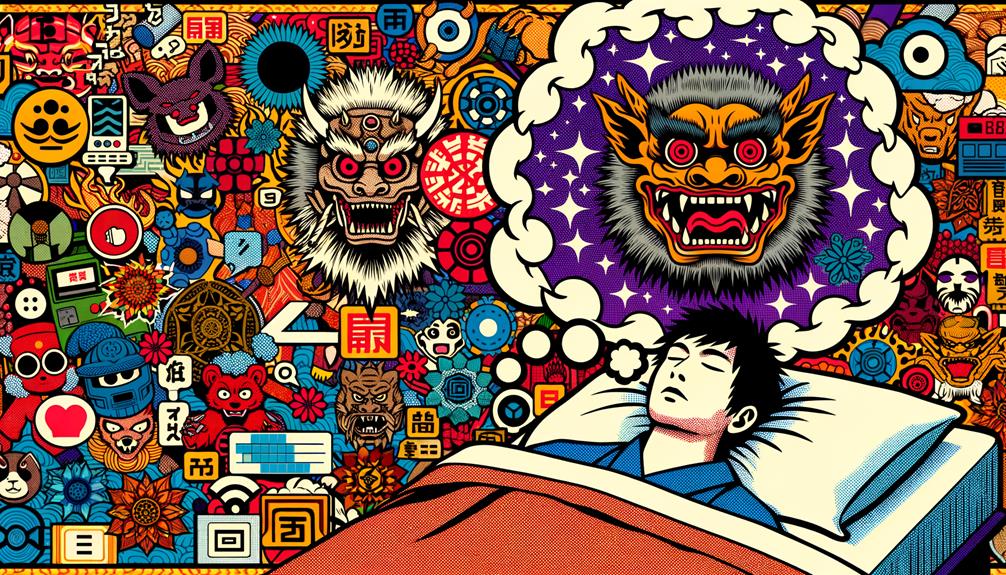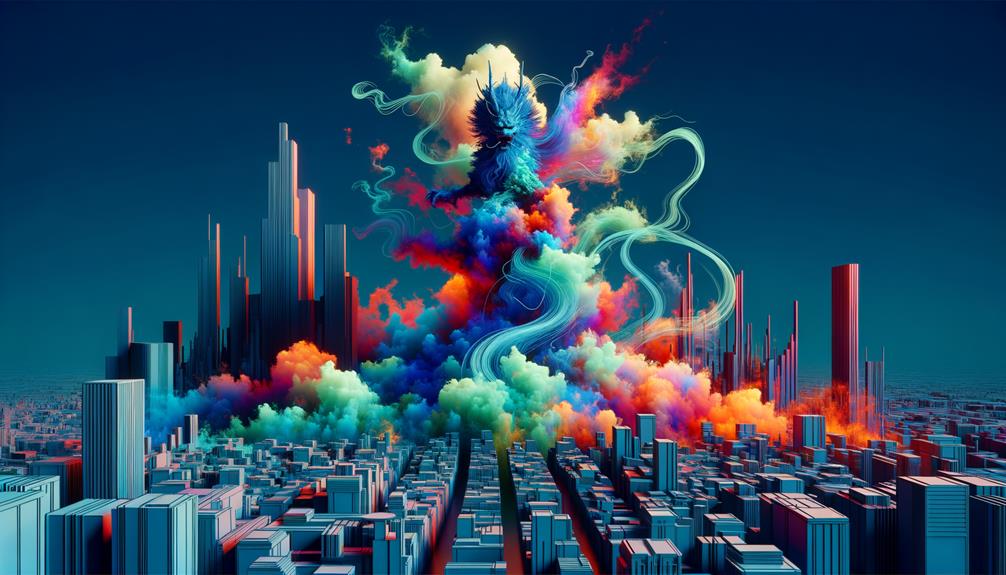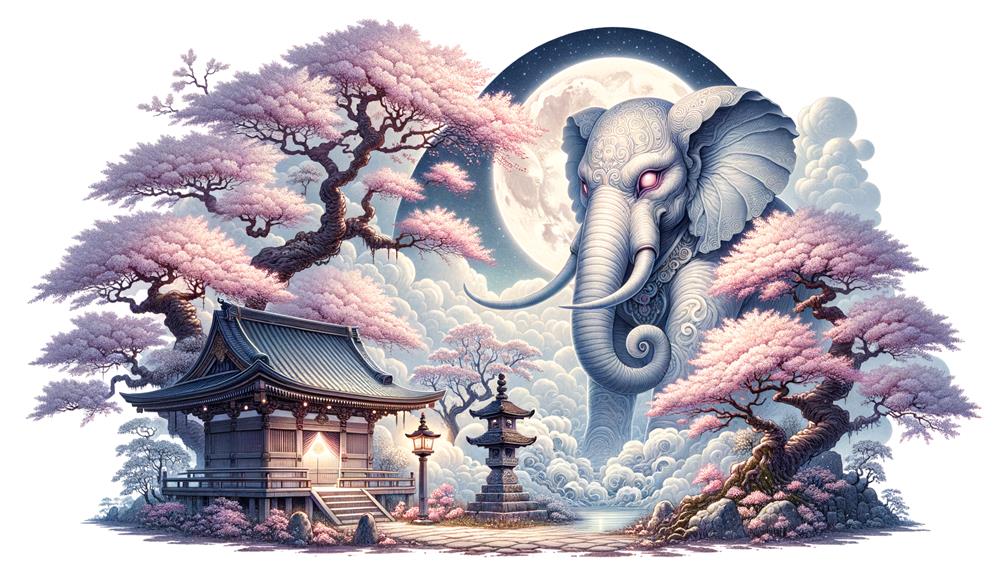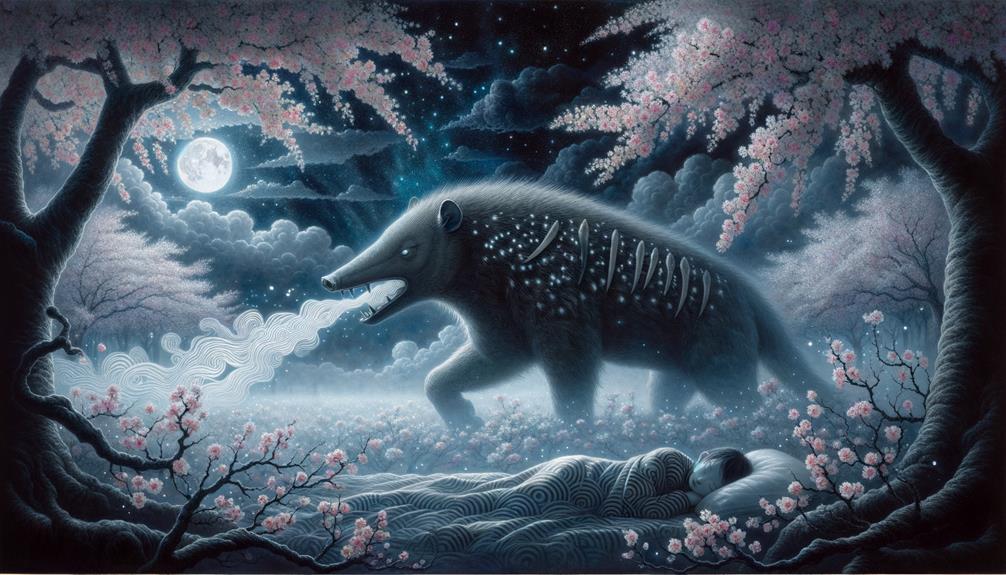The Baku is a captivating creature, originating from Japanese folklore, often referred to as a 'dream-eating spirit.' Its roots trace back to Chinese folklore, where it evolved in Japan during the 14th-15th century. The Baku's image transformed over time, from a supernatural creature into a fascinating entity that consumes dreams. In modern interpretations, it's often depicted as a composite of diverse animals, with a particular resemblance to a tapir.
The Baku plays a soothing role in the world of children by consuming their bad dreams. This mystical allure of the Baku has permeated popular culture, making a worldwide impression. Let's take a closer look at this intriguing symbol of protection that transcends cultures.
Origins of the Baku Legend
The Baku legend, originally stemming from Chinese folklore, made its way to Japan in the 14th-15th century, shifting from an elaborate mythical creature to a respected dream-eating entity. This change from a Chinese mythical creature to a Japanese dream-eating entity is a captivating shift in cultural context that deserves a closer look.
In Japan, the Baku became more than a myth; it was a real source of comfort for children plagued by nightmares. Children would sleep with Baku charms close to their beds, calling on the Baku's protective powers to ensure a good night's sleep. The presence of the Baku in a child's room, embodied in these charms, was a comforting reminder of the Baku's protective nature. This shows how our beliefs can influence how we perceive fear and safety.
The protective role of the Baku is also symbolized in the Konnoh Hachimangu Shrine in Tokyo, where sculptures of the Baku are commonly found next to lions, another potent symbol of protection. This demonstrates how the Baku's roots as a Chinese legend have been effortlessly woven into the tapestry of traditional Japanese beliefs, highlighting the enduring charm of this dream-eating entity.
Depictions of the Dream-Eating Baku
Let's chat about the Baku, a mythical creature from Japanese folklore that's often depicted as a mash-up of various animals. Picture a beast with the body of a bear, the trunk of an elephant, the paws of a tiger, the tail of an ox, and rhinoceros-like ears or eyes. This unique creature, represented in sculptures at spots like Tokyo's Konnoh Hachimangu Shrine, symbolizes the Baku's role as a guardian against nightmares.
In the olden days, children would call upon the Baku's protection. They would keep a charm close to their bed and recite a special phrase, hoping to ward off bad dreams. This charm, a common sight in Japan during the early 1900s, underscores the creature's protective role in the minds of the Japanese folk.
In recent times, though, the Baku has taken on a form that's more like a tapir. This shift from the traditional image doesn't take away from the Baku's protective role but rather updates it for a modern audience. Even in its updated form, the Baku continues to fulfill its age-old role as a devourer of nightmares and guardian of sleep, ensuring its status in Japanese folklore.
Bakus Influence in Popular Culture

The Baku, a creature from Japanese folklore, has managed to make quite a mark on pop culture and not just in Japan. This mythical creature that munches on dreams has found its way into different forms of media, and each interpretation offers a fresh take on the ancient myth. For instance, the Pokemon Drowzee is said to have been influenced by the Baku's dream-eating abilities, which adds an exciting twist to the character's abilities.
Then there's Neil Gaiman's graphic novel, 'The Dream Hunters.' This book gives the Baku a starring role, using its dream-consuming characteristics to weave an enthralling story. The novel pays homage to the Baku's traditional functions while also cementing its place in pop culture.
In the realm of television, the Baku has been referenced in an episode of the series 'Supernatural,' adding yet another notch to its pop culture belt. These mentions in media not only showcase the Baku's power to keep bad dreams at bay but also help boost its popularity among audiences.
In all these varied portrayals, one thing remains constant: the Baku's ability to eat dreams, not just nightmares. This unchanging aspect highlights how folklore can be flexible, evolving from ancient myth to modern interpretations. The Baku's continued relevance in pop culture is a testament to this interesting mix of the old and the new.
Modern Interpretations of Baku

When it comes to the modern take on Baku, this mythical creature now often looks more like a tapir than its original chimera image. This change in how we depict the Baku shows how these mythological creatures can change and evolve over time, as our cultural views and biases shift. The tapir-like appearance, which is similar to an extinct species of the Asian Tapir, could give us a clue to the origin of the dream-eating myth of the Baku.
Nowadays, you find the Baku popping up in Japanese comic books and animated films, which shows how much people are still captivated by this creature. These modern versions of the Baku often highlight the creature's role as a protector, keeping us safe from nightmares – a theme we can all relate to.
This practice of calling on the Baku to keep bad dreams at bay is something that appeals to people all over the world, regardless of their cultural background or the era they live in. You see this appeal in the popularity of talismans and symbols related to the Baku, which shows how people have always been fascinated with the idea of being protected while they sleep.
In the end, the ongoing popularity of the Baku, and how it has changed from a chimera to a tapir-like creature, highlights the dynamic nature of myths and our shared longing for symbols of protection, particularly when it comes to the delicate realm of dreams.
Bakus Role in Japanese Tradition

Let's talk about the Baku, a fascinating creature steeped in Japan's traditional lore. This mythical beast plays a significant role in the world of dreams and nightmares.
You see, the Baku is known for its rather unusual diet – it supposedly eats nightmares. It's like a guardian angel for kids who are scared of bad dreams. It's not just about getting rid of the nightmares though. The Baku also ensures a peaceful night's sleep by forming a protective barrier against any sleep disruptions. This unique trait has given the Baku a special spot in Japanese myths and explains why it remains a popular figure today.
Back in the day, the Japanese took the Baku's protective role a step further by incorporating it into talismans. They believed that these charms could bring the Baku to their aid, providing an additional safeguard against nightmares. It just goes to show how integral the Baku is in Japan's cultural psyche, symbolising protection and guaranteeing restful sleep.
Even now, with all the reinterpretations over the years, the Baku's original job as a nightmare muncher is still acknowledged and appreciated. It's a testament to the lasting impact of this creature on Japanese tradition.
Frequently Asked Questions
What Is the Japanese Myth of Baku?
Ever hear of the Baku? It's a legendary beast from Japan said to gobble up your nightmares, leaving you with peaceful rest. Picture this – an animal with an elephant's snout, the paws of a tiger, and a bear-like physique. Each of these elements symbolizes its role as a guardian against unpleasant dreams. Pretty fascinating, right?
What Is the Japanese Animal That Eats Dreams?
Ever hear of the Baku? It's a rather fascinating figure from Japanese folklore. Legend tells us it's a creature that feasts on dreams, and it's quite an unusual beast, sort of a mix-and-match of different animals. When the little ones in Japan suffer from bad dreams, they often call upon Baku to chase those nightmares away. It's a rather neat tradition, don't you think?
What Does the Japanese Word Baku Mean?
'Baku' is a term you'll encounter in Japanese. It's a two-fold reference. On one hand, it's the name given to an Asian tapir, a real creature you might spot in the wild. But there's also a fascinating mythological side to 'Baku'. Legend paints it as a creature that devours nightmares, serving as a guardian when you're immersed in slumber and promising a restful sleep. It's a captivating blend of the tangible and the mythical, isn't it?
What Does the Baku Symbolize?
The Baku, in the context of Japanese culture, is a powerful symbol of safeguarding from disturbing dreams. Kids in Japan are often told about this spirit, who is said to consume their scary dreams, allowing them a restful sleep. It's an intriguing part of their cultural myths and stories.


